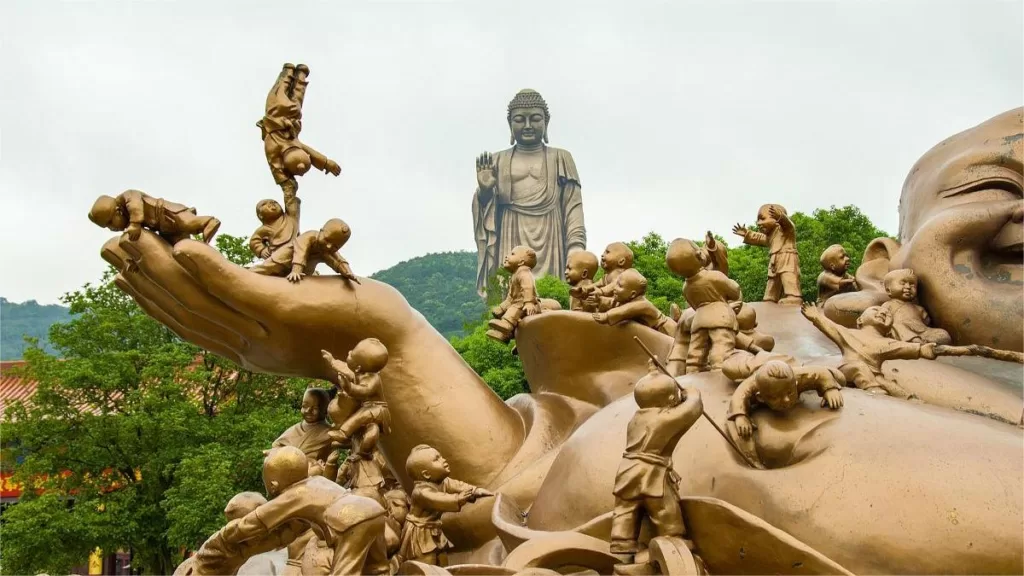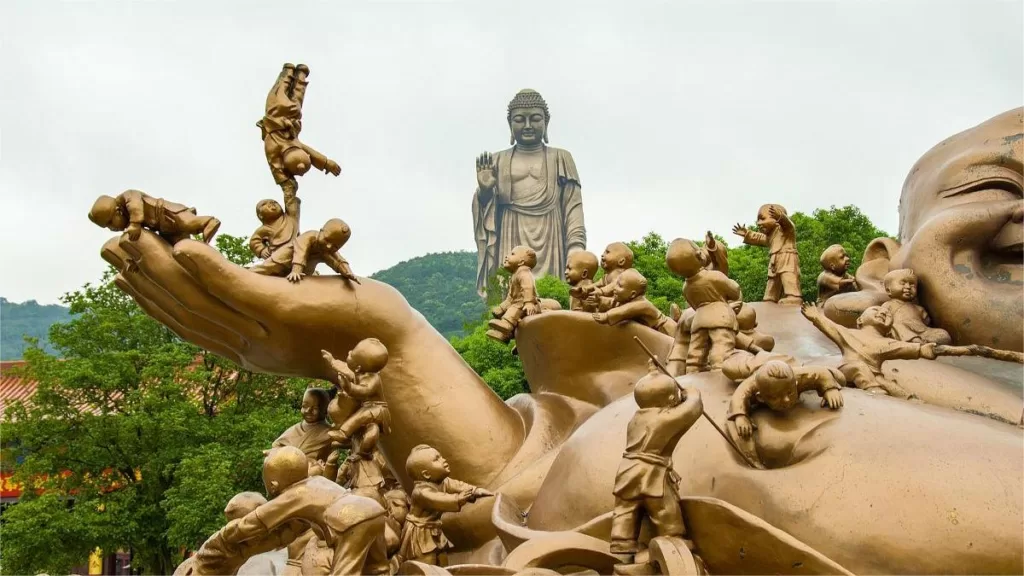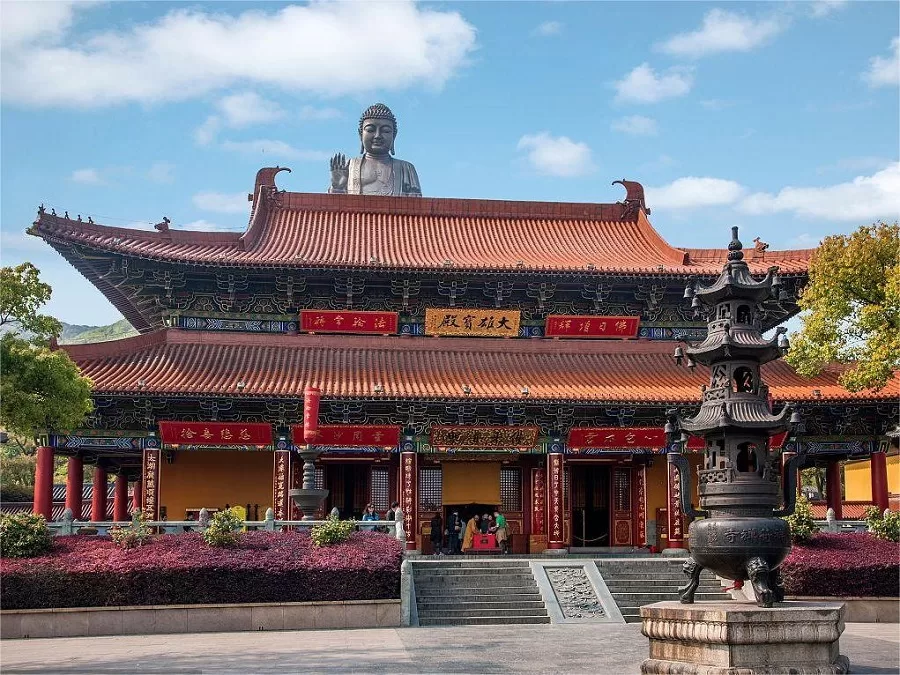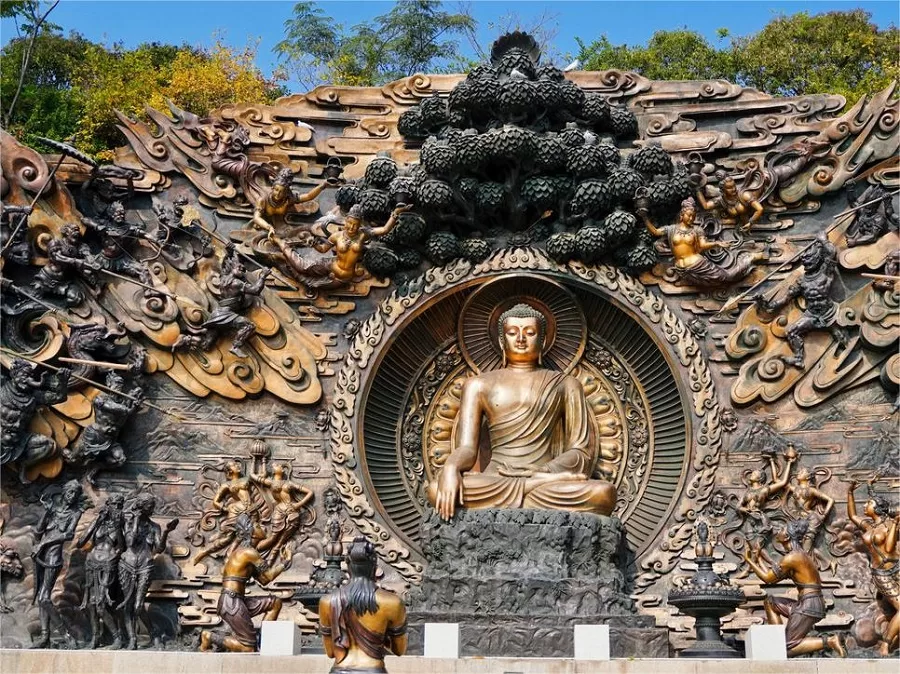Lingshan Buddhist Scenic Area – Ticket Price, Opening Hours, Location, and highlights


Lingshan Buddhist Scenic Area in Wuxi (无锡灵山佛教景区), covering approximately 30 hectares, is not only China’s premier Buddhist tourist destination but also the permanent venue for the World Buddhist Forum. Comprising various key attractions such as Little Lingshan, Xiangfu Zen Temple, the Grand Buddha of Lingshan, the World’s First Palm, Maitreya Buddha’s Hundred Children Play, the Buddhist Culture Exhibition Hall, and the Hall of Ten Thousand Buddhas, this area seamlessly blends the beauty of lakes and mountains with expansive garden squares, Buddhist culture, and historical knowledge.
It stands as the most comprehensive and concentrated embodiment of Buddhist culture, offering a unique opportunity to explore the achievements of Shakyamuni Buddha. Lingshan Buddhist Scenic Area provides a serene and culturally rich environment, inviting visitors to immerse themselves in the profound essence of Buddhism while surrounded by picturesque natural landscapes.
Оглавление
- Основная информация
- Расположение и транспорт
- Highlights of Lingshan Buddhist Area
- Vlog about Lingshan Buddhist Scenic Area
- Полезные советы, обобщенные из обзоров
- Attractions near Lingshan Buddhist Scenic Area
Основная информация
| Сайт | https://www.chinalingshan.com/ |
| Предполагаемая продолжительность тура | Полдня |
| Цена билета | 210 RMB |
| Часы работы | Zen Palace: 9.00 – 18.00 Zen Palace Treasure Gallery: 9.30 – 16.30 Five Seals Altar City: 9.00 – 18.00 Buddhist Culture Exhibition Hall: 8.30 – 17.30 Ten-Thousand Buddha Hall: 8.30 – 16.30 Other Attractions in the scenic area: 7.00 – 17.30 |
| Репутация | Туристическая достопримечательность АААА |
| Номер телефона | 0086-4001680303 |
Расположение и транспорт
Lingshan Buddhist Scenic Area is located in Binhu District, Wuxi City, right on the shores of Taihu Lake in Jiangsu Province. To reach this beautiful destination, you can take either bus route 88 or 89 and alight at the Lingshan Shengjing (Lingshan Scenic Area, 灵山胜境) bus stop, which is right at the entrance to the scenic area.
Highlights of Lingshan Buddhist Area
Lingshan Grand Buddha

The Lingshan Grand Buddha, standing at an impressive height of 88 meters, is the second tallest giant Buddha statue in China. Located in the Lingshan Scenic Area, it faces the majestic Taihu Lake and rests against the backdrop of Lingshan Mountain. With a frame crafted from 725 tons of bronze and assembled from 2000 cast bronze panels, the statue’s right hand forms the “Fearless Mudra” in Buddhism, symbolizing the relief of suffering for all sentient beings. In its left hand, it displays the “Wish-Granting Mudra,” signifying blessings for peace and happiness. The Lingshan Grand Buddha is a remarkable embodiment of spiritual significance and artistic craftsmanship.
Linshan Zen Palace

Lingshan Zen Palace is a multifunctional cultural edifice that seamlessly combines tourism, conferences, exhibitions, and cultural experiences. Nestled against the mountainside, this architectural marvel spans an expansive 50,000 square meters, incorporating elements of Chinese Buddhist grotto art and traditional Buddhist architectural elements. Its exterior features five pagoda-style spires inspired by the “Hua Pagoda” from Dunhuang murals. The highlight of the Zen Palace is the daily performance of “Lingshan Auspicious Chant,” which employs cutting-edge multimedia technology to provide audiences with a captivating visual spectacle, further enhancing the cultural and spiritual ambiance of this magnificent structure.
Five Seals Altar City

The Five Seals Altar City, spanning an area of 8,000 square meters and standing at a height of 31.55 meters with six layers, is a magnificent cultural and religious complex. Within its sacred precincts, it venerates the Five Buddhas representing the five cardinal directions: Bao Sheng Buddha in the South, Amitabha Buddha in the West, Akshobhya Buddha in the North, Ashuku Buddha in the East, and Vairocana Buddha in the center. Its exterior is grand and resplendent, adorned with dazzling golden spires, massive golden vases, prominent sutra pillars, and prayer flags, showcasing the captivating beauty of Tibetan architecture. Inside, it is adorned with colorful murals, wood carvings, thangkas, and gilded decorations, beautifully highlighting Tibetan artistic craftsmanship. Visitors can participate in interactive cultural activities such as lighting butter lamps and spinning prayer wheels within this sacred space.
Xiangfu Zen Temple

Xiangfu Zen Temple, a millennium-old ancient monastery, was first established during the Zhenguan era of the Tang Dynasty. Throughout history, it has been a place of fervent Buddhist worship and a breeding ground for esteemed monks. According to legend, the Tang Dynasty’s Master Сюаньцзан, renowned for his journey to India to obtain Buddhist scriptures, once visited the temple. Struck by the resemblance of the temple’s main peak to the sacred Mount Sumeru from his pilgrimage, he bestowed upon it the name “Xiaolingshan,” meaning “Little Mount Sumeru.” During the Northern Song Dynasty, the temple was renamed “Xiangfu Zen Temple.” Sadly, the temple was destroyed by war in the 1930s but was painstakingly reconstructed in the 1970s, becoming a significant Buddhist sanctuary along the shores of Taihu Lake.
Demon-quelling Bas-relief

The Demon-quelling Bas-relief in Lingshan Buddhist Scenic Area depicts the story of Buddha’s triumph over demons on his path to enlightenment. This massive bronze bas-relief spans 26 meters in width and 8 meters in height. According to legend, after six years of rigorous meditation and asceticism, Shakyamuni Buddha sat under the Bodhi tree, vowing not to leave until he had comprehended the essence of the universe. In the sculpture, Buddha is shown in the center, touching the ground with one hand in the “Demon-quelling Mudra.” On either side, the relief portrays scenes where demons attempted to tempt, slander, and intimidate Buddha using desires, wealth, seduction, and fear. Unmoved by these challenges, Buddha overcame them one by one over seven days and nights, achieving enlightenment and causing the heavens and earth to tremble.
Maitreya Buddha’s Hundred Children Play

Maitreya Buddha’s Hundred Children Play in Lingshan Buddhist Scenic Area presents an endearing and gentle depiction of Maitreya reclining in a relaxed manner, wearing a warm and welcoming smile. Resting upon Maitreya’s colossal form are precisely one hundred mischievous and playful children, each one uniquely crafted and incredibly lifelike. Some are engaged in a game of human pyramid, others are participating in a tug-of-war, a few are playfully poking Maitreya’s navel with small branches, and even the cheekiest among them are depicted urinating on Maitreya’s body. This playful and heartwarming sculpture captures the joyful spirit of innocence and exemplifies the harmonious blend of artistry and spirituality found in the Lingshan Buddhist Scenic Area.
Buddhist Culture Exhibition Hall

The Buddhist Culture Exhibition Hall in Lingshan Buddhist Scenic Area is a comprehensive showcase of China’s rich Buddhist heritage. Spanning 10,000 square meters, the exhibition hall delves into various aspects of Buddhist culture, including the Five Buddhas of Chinese Buddhism, as well as the three major Buddhist traditions: Tibetan, Theravada, and Mahayana. Through detailed textual descriptions, images, artifacts, and multimedia presentations, the hall provides a comprehensive overview of the historical origins, spread, evolution, and profound influence of Buddhism on Chinese culture and art. It serves as a testament to the vast and enduring nature of Buddhist culture, offering visitors a deep appreciation of its spiritual and historical significance.
Nine Dragons Bathing

Nine Dragons Bathing in Lingshan Buddhist Scenic Area is a magnificent bronze sculpture resembling a blooming lotus. Supported by four powerful figures, it stands above a circular white marble pool. Surrounding this grand pool are nine flying dragons and eight diverse offerings, forming a mesmerizing scene. When the music of “Birth of the Buddha” begins to play, the six large lotus petals slowly unfurl. From within the lotus, a 7.2-meter-tall golden statue of the Prince Siddhartha Buddha emerges, with one hand pointing to the sky and the other to the ground. Simultaneously, the nine dragons spray water columns, bathing the Prince Siddhartha Buddha in a stunning display of artistry and spirituality.
Vlog about Lingshan Buddhist Scenic Area
Полезные советы, обобщенные из обзоров
График выступлений:
- Nine Dragons Bathing Sutra: 10:00, 11:30, 14:45, 16:40 (Weekdays); additional show at 13:00 on Saturdays and Sundays.
- Lingshan Auspicious Chant: 10:35, 11:30, 14:00, 16:00 (Weekdays); additional show at 13:00 on Saturdays and Sundays.
- Fan Gong Cultural Experience Tour: 11:00, 12:00, 13:30, 15:30.
Варианты питания:
- Vegetarian restaurant on the right side of the Ashoka Pillar offers a variety of dishes, including vegetarian noodles and dumplings priced at 35 yuan.
- Fan Gong’s second and third floors at Wuguan Tang offer a Pure Vegetarian Buffet for 60 yuan per person, with a 20 yuan rate for children under 1.4 meters. Lingshan Zhai Mixed Vegetarian and Non-vegetarian Set Meal is available for 98 yuan per person, and there are also group packages and private rooms.
- Near the Buddha’s Foot Altar on the right side, within the scenic area, the Lingshan Holiday Square has a food court with a rich variety of cuisines. Prices are reasonable. Be cautious not to exit the scenic area, as re-entry might not be possible.
Экскурсионный автомобиль:
- A sightseeing car is available for 40 yuan, offering unlimited rides. Given the vastness of the scenic area, purchasing this option is highly recommended.
Attractions near Lingshan Buddhist Scenic Area

Залив Няньхуа
Местная жизнь Цзянсу, Достопримечательности Уси